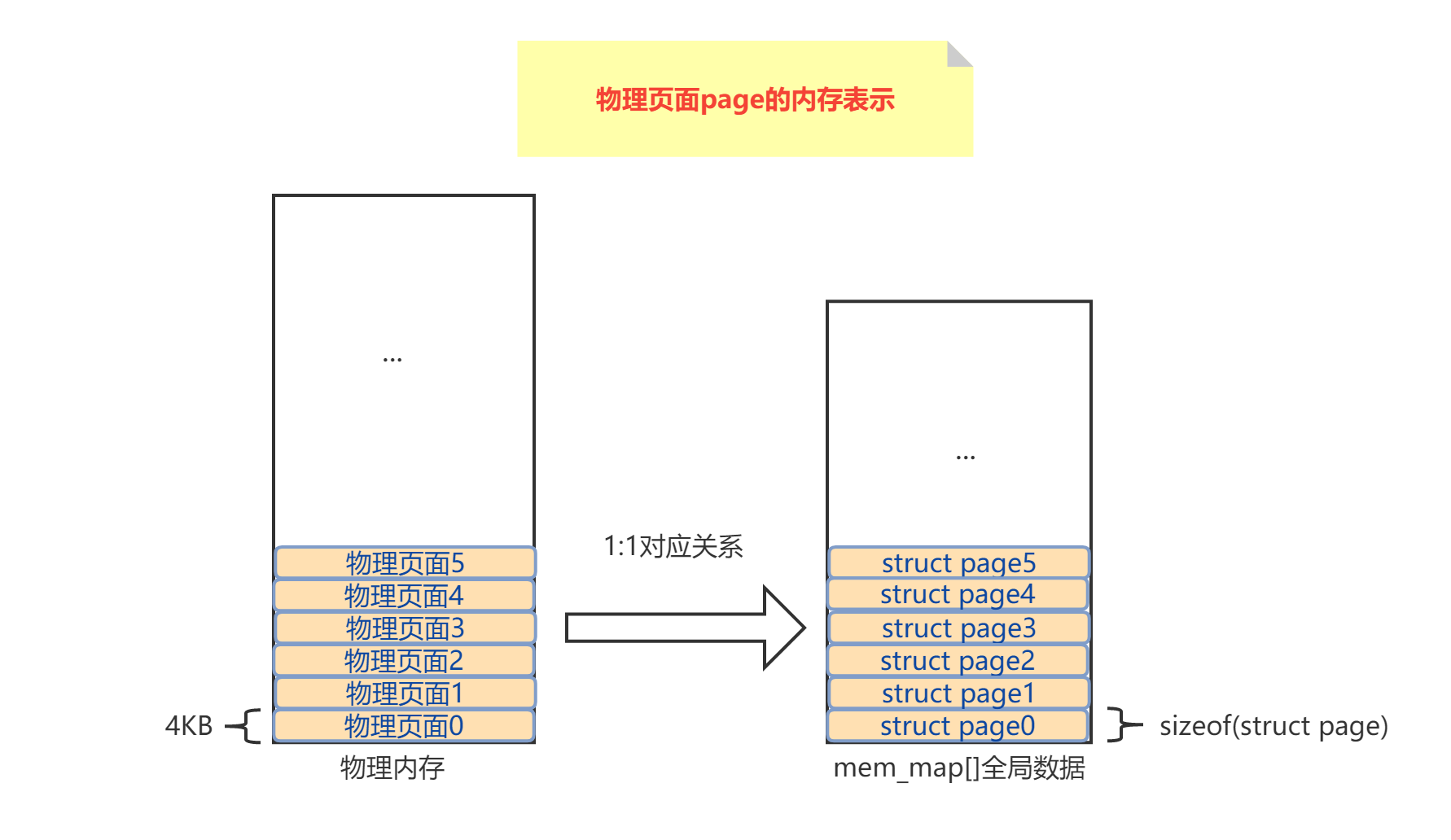几个问题:
1.当开启了MMU之后,CPU访问内存的最小单位是多少呢?
page
2.linux怎样描述这个页呢?
3.linux内核里,怎么理解和使用这个页?
linux内核用stuct page来描述一个物理页面:
1.简化版的page结构体
/*
* page描述一个物理页面
*/
struct page {
unsigned long flags;
atomic_t _refcount;
atomic_t _mapcount;
unsigned long private;
struct address_space *mapping;
pgoff_t index;
struct list_head lru;
void * *virtual;
} _struct_page_alignment;flags字段:
enum pageflags {
PG_locked, /* Page is locked. Don't touch. */ ///表示页面已经上锁;如果该比特位置位,说明已经被锁,内存管理其他模块不能访问这个页面,防止竞争
PG_referenced, ///同PG_active一起,用于控制页面的活跃程度,在kswapd页面回收中使用;
PG_uptodate, ///表示页面的数据已经从块设备成功读取到内存页面;
PG_dirty, ///表示页面内容发生改变,这个页面为脏的,即页面内容被改写,还没同步到外部存储器
PG_lru, ///表示页面加入了LRU链表中,内核使用LRU链表来管理活跃和不活跃页面;
PG_active,
PG_workingset,
PG_waiters, /* Page has waiters, check its waitqueue. Must be bit #7 and in the same byte as "PG_locked" */
PG_error, /////表示页面操作过程中发生错误时会设置该位;
PG_slab, ///页面用于slab分配器
PG_owner_priv_1, /* Owner use. If pagecache, fs may use*/
PG_arch_1,
PG_reserved,
PG_private, /* If pagecache, has fs-private data */
PG_private_2, /* If pagecache, has fs aux data */
PG_writeback, /* Page is under writeback */ ///表示页面的内容正在向块设备进行会写
PG_head, /* A head page */
PG_mappedtodisk, /* Has blocks allocated on-disk */
PG_reclaim, /* To be reclaimed asap */ ///表示这个页面马上要被回收
PG_swapbacked, /* Page is backed by RAM/swap */ ///表示页面具有swap缓存功能,通过匿名页面才可以写回swap分区
PG_unevictable, /* Page is "unevictable" */ ///表示这个页面不能回收
#ifdef CONFIG_MMU
PG_mlocked, /* Page is vma mlocked */ ///表示页面对应的vma处于mlocked状态;
#endif
#ifdef CONFIG_ARCH_USES_PG_UNCACHED
PG_uncached, /* Page has been mapped as uncached */
#endif
#ifdef CONFIG_MEMORY_FAILURE
PG_hwpoison, /* hardware poisoned page. Don't touch */
#endif
#if defined(CONFIG_IDLE_PAGE_TRACKING) && defined(CONFIG_64BIT)
PG_young,
PG_idle,
#endif
#ifdef CONFIG_64BIT
PG_arch_2,
#endif
__NR_PAGEFLAGS,
/* Filesystems */
PG_checked = PG_owner_priv_1,
/* SwapBacked */
///表示页面处于交换缓存
PG_swapcache = PG_owner_priv_1, /* Swap page: swp_entry_t in private */
/* Two page bits are conscripted by FS-Cache to maintain local caching
* state. These bits are set on pages belonging to the netfs's inodes
* when those inodes are being locally cached.
*/
PG_fscache = PG_private_2, /* page backed by cache */
/* XEN */
/* Pinned in Xen as a read-only pagetable page. */
PG_pinned = PG_owner_priv_1,
/* Pinned as part of domain save (see xen_mm_pin_all()). */
PG_savepinned = PG_dirty,
/* Has a grant mapping of another (foreign) domain's page. */
PG_foreign = PG_owner_priv_1,
/* Remapped by swiotlb-xen. */
PG_xen_remapped = PG_owner_priv_1,
/* SLOB */
PG_slob_free = PG_private,
/* Compound pages. Stored in first tail page's flags */
PG_double_map = PG_workingset,
/* non-lru isolated movable page */
PG_isolated = PG_reclaim,
/* Only valid for buddy pages. Used to track pages that are reported */
PG_reported = PG_uptodate,
};flags布局
flags成员除了上述重要标志位之外,还有个重要作用,就是存放SECTION编号,node节点编号,zone编号等;
比如在ARM Vexpress平台中page->flags布局图,bit[0:43]用来存放页面标志位,bit[44:59]用于NUMA平很算法中的LAST_CPUPID,bit[60:61]用于存放zone编号bit[62:63]存放node编号;
|63node62|61zone60|59LASTCPUPID44|43flags0|
linux内核里一般不直接操作变量,linux提供了一些列的接口函数,尽量使用这些封装好的接口;
static inline struct zone *page_zone(const struct page *page)
static inline void set_page_zone(struct page *page, enum zone_type zone)_refcount字段:
当_refcount等于0时,表示该page页面为空闲或即将要被释放的页面;
当_refcount大于0时,表示该page页面已经被分配且内核正在使用,暂时不会被释放
static inline void get_page(struct page *page) ///_refcount加一
static inline void put_page(struct page *page) ///_refcount减一,若_refcount==0,会释放该页面
static inline int page_count(struct page *page) ///统计_count个数_refcount使用场景
(1)初始状态,空闲页面,_refcount=0;
(2)分配页面时,_refcount会变成1;
(3)加入LRU链表时,页面会被kswapd内核线程使用,_refcount会加1;
添加到LRU链表后,_refcount减1,防止页面在添加到LRU过程中被释放;
(4)被映射到其他用户进程的PTE时,_refcount会加1.
(5)页面的private成员指向私有数据;
对于PG_swapable的页面,__add_to_swap_cache()增加_refcount;
对于PG_private页面,主要在块设备的buffer_head中使用,如buffer_migrate_page()会增加_refcount;
(6)内核对页表进行操作等关键路径上也会使_refcount加1.
_mapcount字段:
_mapcount引用计数,表示这个页面被进程映射的个数,即已经映射了多少个用户pte页表。
在ARM64的Linux内核中,每个用户进程都拥有一个独立的虚拟地址空间和独立的页表,所以有可能出现多个用户进程虚拟地址映射到一个物理页面,RMAP反向映射系统就是利用这个特性来实现的。
_mapcount引用计数,主要用于RMAP反向映射系统中;
_mapcount==-1,表示没有用户vma映射到页面中;
_mapcount==0,表示只有父进程映射了页面,匿名页面刚分配时,_mapcount引用计数初始化为0;
_mapcount>0:有多个用户vma映射该页
访问:
page_dup_rmap();///增加_refcount
static inline int page_mapcount(struct page *page); ///统计_mapcount个数mmaping字段:
对于匿名页面,mapping指向VMA的anon_vma结构;
对于交换高速缓存页面,mapping指向交换分区的swapper_spaces;
对于文件映射页面,mapping指向该文件所属的address_space结构,它包含文件所属的介质相关信息,如inode节点,节点对应操作方法等;
address_space为8字节对齐,低两位用于其它用途:
bit[0]:判断该页面是否为匿名页面;
bit[1]:判断该页面是否为非LRU页面;
bit[01]==0b11,表示这是一个KSM页面;
static __always_inline int PageAnon(struct page *page) ///判断是否为匿名页面
static __always_inline int __PageMovable(struct page *page) ///判断是否为非LRU页面
static __always_inline int PageKsm(struct page *page) ///判断是否为KSM页面
void *page_rmapping(struct page *page) ///返回mapping成员,清除低2位;
struct address_space *page_mapping(struct page *page) ///返回mapping成员指向的地址空间
bool page_mapped(struct page *page) ///判断该页面是否映射到用户PTEindex
映射中的页偏移
文件页:页相对于文件起始位置的页偏移;
匿名页:页相对于VMA起始位置的页偏移;
lru字段:
用在页面回收的LRU链表算法中,LRU链表算法定义了多个链表;
用来把一个slab添加到slab满链表、slab空闲链表或slab部分链表中;
virtual字段:
一个指向页所对应的虚拟地址的指针;
页面锁PG_Locked:
struct page数据结构成员flags定义了一个标志PG_locked;内核通常用PG_locked来设置一个页面锁;
static inline void lock_page(struct page *page) ///用于申请页面锁,如果页面锁被其他进程占用,那么会睡眠等待;
static inline int trylock_page(struct page *page) ///如果返回false表示获取锁失败,返回true表示获取锁成功;不会睡眠
2.struct page 的意义;
内核使用struct page来描述一个物理页面,我们看到了管理这些页面的信息,比如:
(1)内核知道当前这个页面的状态(通过flags字段);
(2)内核需要知道一个页面是否空闲,即有没有分配出去,有多少个进程(_count)或内存路径访问了这个页面(_mapcount);
(3)内核知道谁在使用这个页面,使用者是用户空间进程的匿名页,还是page cache(mapping);
(4)内核知道这个页面是否被slab即使使用(lru, s_mem等字段);
(5)内核知道这个页面是否线性映射(virtual);
3.struct page数据结构存放在哪里?
page存放在一个全局数组mem_map[]中;

注意:存放的是struct page结构体,不是指针;
4.总结
Linux内核的内存管理以page页面为核心,struct page数据结构提供了很多字段,其中_refcount和_mapcount是两个非常重要的引用计数,正确理解它们是理解Linux内核内存管理的基石。
_refcount是page页面的“命根子”;
_mapcount是page页面的“幸福指数”
struct page是Linux内核最重要的数据结构之一,想深入研究Linux内存管理,有必要慢慢研究struct page中重要成员的含义和用法。